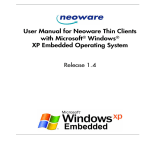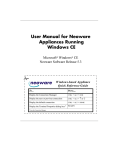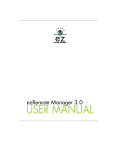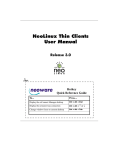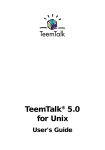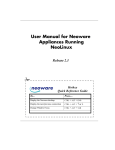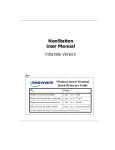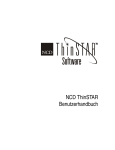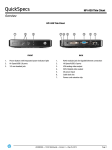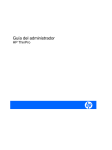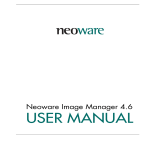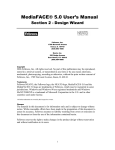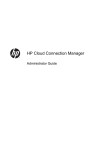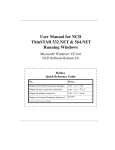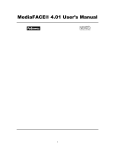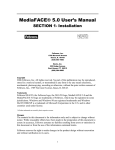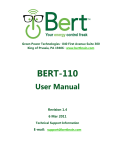Download User Manual for Neoware Thin Client Appliances with Microsoft
Transcript
User Manual for Neoware Thin Client Appliances with Microsoft® Windows® XP Embedded Operating System i Copyright © 2002 by Neoware Systems, Inc. 400 Feheley Drive King of Prussia, PA 19406 USA +1.610.277.8300 E-mail: [email protected] Please check Neoware’s Web site for the most recent version of this document: http://www.neoware.com This manual is copyrighted by Neoware Systems, Inc. All rights are reserved. This document may not, in whole or in part, be copied, photocopied, reproduced, translated, or reduced to any electronic medium or machine-readable form without prior consent, in writing, from Neoware Systems, Inc. Neoware, Capio, Eon, ThinSTAR, and ezRemote Manager are trademarks of Neoware Systems, Inc. Windows and Microsoft are registered trademarks of Microsoft Corporation. MetaFrame, WinFrame, and ICA are registered trademarks of Citrix Systems, Inc. Other trademarks used in this manual are the property of their respective owners. Disclaimer: The information provided in this manual is intended for instructional purposes only and is subject to change without notice. Neoware Systems, Inc., accepts no responsibility or liability for errors, omissions, or misleading information that may be contained in this manual. Production note: This manual was entirely designed, written, edited, and illustrated on Neoware thin client appliance computers using Neoware’s embedded software. 9.4.2002 ii FCC regulatory and safety information FCC regulatory and safety information can be found in the Quick-Start Guide that came with your appliance, and on the Support section of the Neoware website which can be found at: http://www.neoware.com/support.html CANADA ICES/NMB-003 Class/Classe (B) This Class B digital apparatus complies with Canadian ICES-003. Cet appareil numérique de la classe B est conform à la norme NMB-003 du Canada. Neoware Hardware Warranty Neoware hardware warranties can be found in the Quick-Start Guide that came with your appliance, and on the Support section of the Neoware website which can be found at: http://www.neoware.com/support.html Microsoft Software License Microsoft's Embedded Systems End User License Agreement (“EULA”) PLEASE READ THIS ENTIRE DOCUMENT CAREFULLY. • You have acquired a Windows XP Embedded based computing appliance (“DEVICE”) that includes software licensed by Neoware Systems, Inc. from Microsoft Licensing Inc. or its affiliates (“MS”). Those installed software products of MS origin, as well as associated media, printed materials, and “online” or electronic documentation (“SOFTWARE”) are protected by copyright laws and international copyright treaties, as well as other intellectual property laws and treaties. The SOFTWARE is licensed, not sold. • IF YOU DO NOT AGREE TO THIS END USER LICENSE AGREEMENT (“EULA”), DO NOT USE THE DEVICE OR COPY THE SOFTWARE. INSTEAD, PROMPTLY CONTACT NEOWARE SYSTEMS, INC. FOR INSTRUCTIONS ON RETURN OF THE UNUSED DEVICE(S) FOR A REFUND. ANY USE OF THE SOFTWARE, INCLUDING BUT NOT LIMITED TO USE ON THE DEVICE, WILL CONSTITUTE YOUR AGREEMENT TO THIS EULA (OR RATIFICATION OF ANY PREVIOUS CONSENT). • GRANT OF LICENSE. The SOFTWARE is licensed, not sold. This EULA grants you the following rights to the SOFTWARE: - You may use the SOFTWARE only on the DEVICE. - NOT FAULT TOLERANT. THE SOFTWARE IS NOT FAULT TOLERANT. NEOWARE SYSTEMS, INC. HAS INDEPENDENTLY DETERMINED HOW TO USE THE SOFTWARE IN THE DEVICE, AND MS HAS RELIED UPON NEOWARE SYSTEMS, INC. TO CONDUCT SUFFICIENT TESTING TO DETERMINE THAT THE SOFTWARE IS SUITABLE FOR SUCH USE. FCC regulatory and safety information iii - NO WARRANTIES FOR THE SOFTWARE. THE SOFTWARE is provided “AS IS” and with all faults. THE ENTIRE RISK AS TO SATISFACTORY QUALITY, PERFORMANCE, ACCURACY, AND EFFORT (INCLUDING LACK OF NEGLIGENCE) IS WITH YOU. ALSO, THERE IS NO WARRANTY AGAINST INTERFERENCE WITH YOUR ENJOYMENT OF THE SOFTWARE OR AGAINST INFRINGEMENT. IF YOU HAVE RECEIVED ANY WARRANTIES REGARDING THE DEVICE OR THE SOFTWARE, THOSE WARRANTIES DO NOT ORIGINATE FROM, AND ARE NOT BINDING ON, MS. - Note on Java Support. The SOFTWARE may contain support for programs written in Java. Java technology is not fault tolerant and is not designed, manufactured, or intended for use or resale as online control equipment in hazardous environments requiring fail-safe performance, such as in the operation of nuclear facilities, aircraft navigation or communication systems, air traffic control, direct life support machines, or weapons systems, in which the failure of Java technology could lead directly to death, personal injury, or severe physical or environmental damage. Sun Microsystems, Inc. has contractually obligated MS to make this disclaimer. - No Liability for Certain Damages. EXCEPT AS PROHIBITED BY LAW, MS SHALL HAVE NO LIABILITY FOR ANY INDIRECT, SPECIAL, CONSEQUENTIAL OR INCIDENTAL DAMAGES ARISING FROM OR IN CONNECTION WITH THE USE OR PERFORMANCE OF THE SOFTWARE. THIS LIMITATION SHALL APPLY EVEN IF ANY REMEDY FAILS OF ITS ESSENTIAL PURPOSE. IN NO EVENT SHALL MS BE LIABLE FOR ANY AMOUNT IN EXCESS OF U.S. TWO HUNDRED FIFTY DOLLARS (U.S.$250.00). - Limitations on Reverse Engineering, Decompilation, and Disassembly. You may not reverse engineer, decompile, or disassemble the SOFTWARE, except and only to the extent that such activity is expressly permitted by applicable law notwithstanding this limitation. - SOFTWARE Transfer allowed but with restrictions. You may permanently transfer rights under this EULA only as part of a permanent sale or transfer of the Device, and only if the recipient agrees to this EULA. If the SOFTWARE is an upgrade, any transfer must also include all prior versions of the SOFTWARE. - EXPORT RESTRICTIONS. If these licensing terms are not labeled “North America Only Version” and the SOFTWARE is not identified as “North America Only Version” on the SOFTWARE packaging or other written materials, then the following terms apply: Export of the SOFTWARE from the United States is regulated by the Export Administration Regulations (EAR, 15 CFR 730-744) of the U.S. Commerce Department, Bureau of Export Administration (BXA). You agree to comply with the EAR in the export or re-export of the SOFTWARE: (i) to any country to which the U.S. has embargoed or restricted the export of goods or services, which as of May 1999 include, but are not necessarily limited to Cuba, Iran, Iraq, Libya, North Korea, Sudan, Syria, and the Federal Republic of Yugoslavia (including Serbia, but not Montenegro), or to any national of any such country, wherever located, who intends to transmit or transport the SOFTWARE back to such country; (ii) to any person or entity who you know or have reason to know will utilize the SOFTWARE or portion thereof in the design, development or production of nuclear, chemical, or biological weapons; or (iii) to any person or entity who has been prohibited from participating in U.S. export transactions by any federal agency of the U.S. government. You warrant and represent that neither the BXA nor any other U.S. federal agency has suspended, revoked or denied your export privileges. For additional information see http://www.microsoft.com/exporting/. Microsoft OEM Customer License Agreement For Embedded Systems iv Microsoft Software License Safety Instructions Please read these safety instruction carefully and keep this user’s manual for later reference. 1. Before removing the outer case from the thin client appliance always disconnect the AC power cord to prevent the possibility of dangerous electrical shock. 2. Before cleaning, disconnect the thin client appliance from AC power. Do not use liquid or sprayed cleaning products to clean the unit. Instead, use a moistened sheet or cloth for cleaning. 3. Be sure not to expose the thin client appliance from excessive humidity. 4. Be sure to install the thin client appliance on a secure surface. A falling device could cause injury. 5. Place the power cord in such a way to avoid people stepping on it. Do not place anything over the power cord. 6. Be sure to note all cautions and warnings on the thin client appliance. 7. If the thin client appliance is not used for a long period of time, disconnect the AC power to avoid damage caused by voltage transients. 8. Never pour any liquid into any thin client appliance openings: This could cause fire or electrical shock. 9. If one of the following situation occurs, be sure to get the thin client appliance checked by a qualified service technician: a. The power cord or plug is damaged. b. Liquid penetrates the thin client appliance case. c. The thin client appliance is exposed to moisture. d. The thin client appliance does not work well or you cannot get it to work according to the user’s manual. e. The thin client appliance has been dropped or damaged. f. If the thin client appliance has obvious signs of breakage. 10. The thin client appliance should be stored and used only in temperature and humidity controlled environments. Storing appliances below -20°C (-4°F) or above 60°C (140°F) may cause damage. 11. The sound pressure level at the operators position according to IEC 704-1:1982 is equal or less to 70dB(A). 12. The input power cord shall be minimum H05VV-F, 3G, 0.75mm², rate minimum 6A. 13. The thin client appliance should be used only where ambient air temperatures are maintained below 40°C. Safety Instructions v vi Safety Instructions Windows XPe Appliance User Manual Table of Contents FCC regulatory and safety information iii CHAPTER 1 CANADA ICES/NMB-003 Class/Classe (B) iii Neoware Hardware Warranty Microsoft Software License Safety Instructions iii iii Unpacking your Neoware thin client appliance 13 Packaging contents 13 v Table of Contents vii Introduction 9 Overview 9 Purpose and intended readers 9 Organization 9 What is a Neoware XPe thin client appliance? 10 Getting More Information 11 The Internet 11 Technical support 11 Setting Up Your Neoware Thin Client Appliance 13 Connecting the components 14 Back panel connectors 14 Connecting the cables 15 Connecting Parallel and Serial peripheral devices 15 Arranging Your work area 16 Getting comfortable 16 CHAPTER 2 Logging On 17 Preconfigured logon accounts 17 Neoware default logon accounts 17 Logging on using the default logon accounts 17 Automatic logon 18 To enable auto logon 18 vii Table of Contents To disable auto logon Domain logon 19 Enabling domain logon CHAPTER 3 Microsoft Windows Media Player 19 20 CHAPTER 4 Applications Citrix Program Neighborhood 23 24 Macromedia Flash™ Plug-In 30 viii Task Manager 34 35 35 Remote management and configuration ezRemote Manager 36 Download ezRemote Manager 37 30 Adobe® Acrobat® Reader Plug-In 33 USB device support 36 26 Pericom teemTALK XPe 27 Supported emulations 27 Setting up teemTALK XPe connections 28 Microsoft Virtual Machine Mapping network drives Roaming profiles 24 Microsoft Remote Desktop Connection Microsoft Internet Explorer 6.0 Technical Notes File storage configuration 33 Flash disk 33 Temporary RAM disk 33 23 Overview 23 Standard configurations and snap-ins 30 30 Index 39 36 Windows XPe Appliance User Manual Introduction This introduction describes the purpose and structure of this manual, as well as other sources of information. Overview Purpose and intended readers This manual explains how to use Neoware thin client appliances that are powered by Neoware software incorporating the Microsoft Windows XP Embedded (XPe) operating system. It is intended for administrators and evaluators. Organization It is recommended that you read the chapters of this manual in order. The main topics covered are: • Unpacking and setting up your thin client appliance. • Logging on to your appliance and configuring Logon accounts. • Details of the pre-installed software applications on your appli- ance. • Technical notes This manual does not explain how to use the Windows desktop or Windows-based applications. To learn how to use them, read the documentation provided with the applications. 9 Introduction What is a Neoware XPe thin client appliance? Using a Neoware XPe thin client appliance lets you harness the power of Microsoft’s Windows XP Embedded in a smart, customizable, manageable appliance without a hard drive, fan or other moving parts for a completely silent, long-lived operation. Neoware’s XPe thin client appliances run Microsoft's industry-standard XPe operating system. Neoware’s open approach to XPe means that you can customize our XPe appliances to fit virtually any computing environment. In addition Neoware has added its ezFeatures which include: • ezManage – Full remote management capabilities built into every version of Neoware software. With Neoware’s remote management software suite — ezRemote Manager — customers can update and configure Neoware appliances without ever visiting the desktop. ezRemote Manager software provides administrators with complete central management including device discovery, asset management, remote configuration, remote software updates, and installation of additional software components (via Neoware’s ezSnap technology). Also, using ezRemote Manager administrators can copy a customized configuration from one XPe appliance to another, or to thousands of others. • ezSecure – ezSecure refers to the ability of system administrators to completely lock down Neoware software from unauthorized user intervention. • ezSnap – Add new functionality, update existing software, or modify configurations in your Neoware thin client appliances without having to upload or download an entire software image. Neoware XPe appliances can connect to servers running Microsoft Windows .NET Server, Microsoft Windows 2000 Server (as well as Advanced Server and Datacenter Server versions), Microsoft Windows NT 4.0 Server, Terminal Server Edition (TSE), and to servers that are running Citrix MetaFrame, WinFrame. Using Pericom teemTALK terminal emulation suite (optional), you can also connect to mainframes and midrange computers. Your XPe appliance also comes fully configured to communicate with USB, serial, and parallel devices, and (depending on the hardware series) may include a PCI/ISA slot for expandability. These features allow you to connect 10 Overview Introduction printers, modems, bar code scanners, and other peripheral devices to your appliance. Neoware thin client appliances aren’t difficult to use. If you know how to use a personal computer, or even if you don’t, you can use a Neoware thin client appliance. Getting More Information The Internet Current and archival information about Neoware products, including the latest software updates, is available at: http://www.neoware.com In addition, this user manual and other Neoware documentation are available at the Neoware Web site for browsing or downloading. Technical support For technical support regarding Neoware products, call Neoware at +1.610.277.8300 or send an e-mail message to [email protected]. Getting More Information 11 Introduction 12 Getting More Information Windows XPe Appliance User Manual CHAPTER 1 Setting Up Your Neoware Thin Client Appliance This chapter describes how to set up your thin client appliance. Packaging contents Your Neoware-powered thin client appliance typically is shipped in cartons, containing these items. Depending on the shipping configuration, one or more of the items may be contained in separate shipping cartons (such as a monitor, keyboard, and mouse): Thin Client Appliance • A keyboard with cable attached. • A mouse with cable attached. • A power cable. • Stabilizing feet or stand for using the thin client appliance in a vertical orientation. Monitor • A monitor power cable (attached to some monitors). • A monitor video cable (attached to most monitors). • A tilt/swivel base, attached or unattached. To unpack your Neoware appliance, open the cartons carefully, remove the components, and save the packing materials in case you need to repack them. 13 Setup Unpacking your Neoware thin client appliance Setting Up Your Neoware Thin Client Appliance Connecting the components Back panel connectors The following is an explanation of the different connections that can be found on Neoware thin client appliances. • MOUSE is a PS/2-type mouse port (green-colored connec- FYI The serial and parallel ports can be used with ICA and terminal emulation connections. tor marked with the word “MOUSE” or with the icon displayed here). • KEYBOARD is a PS/2-type keyboard port (purple-col- ored connector marked with the word “KEYBOARD” or with the icon displayed here). • LAN is an RJ-45 jack. The appliance automatically detects and connects to either 10BaseT or 100BaseT (twistedpair) Ethernet. • PARALLEL is a standard DB-25 parallel port for local printers. • COM 1 and COM 2 are DB-9, RS-232 serial ports. Depending on which software version is loaded in the thin client appliance, serial ports may be used for peripheral devices such as modems, personal digital assistants (PDAs), and bar code scanners. • USB ports (two Type A USB ports). • MIC is a 3.5 mm microphone jack. • LINE IN is a 3.5 mm line audio input jack. • LINE OUT is a 3.5 mm audio output jack. • MONITOR is a standard DB-15, high-density, VGA-type monitor connector. • The power supply connects through the supplied power cable. It automatically detects and accepts either 120 VAC or 240 VAC line voltage. 14 Connecting the components Setting Up Your Neoware Thin Client Appliance Connecting the cables 1 Arrange your appliance and monitor in your work area. 2 Connect the monitor power cable to a power source. 3 Connect the power cord into the socket. Make sure the appli- ance is powered off. 4 Connect the keyboard cable to the KEYBOARD (purple) port. 5 Connect the mouse cable to the MOUSE (green) port. 6 Connect the monitor video cable to the MONITOR port. Don’t overtighten the screws. The video cable connection to the monitor varies. Some monitors have attached video cables. 7 Connect a twisted-pair, 10BaseT or 100BaseT Ethernet cable into the LAN jack. You can connect a modem, printer, bar code scanner, and other peripheral devices to your appliance. Setup Connecting Parallel and Serial peripheral devices 1 If your appliance is turned on, log off all its open connections, and then turn off the appliance. 2 If you have a local printer, connect its cable to the PARAL- LEL port. You can also attach local serial printers to either serial port: COM 1 or COM 2. 3 If you have an external modem, bar code scanner, or other serial device, connect its cable to a serial port (COM 1 or COM 2). Which serial port devices will work with your thin client appliance depends on the software version loaded in the device. Not all software versions support all serial devices. 4 Turn on your appliance and then the peripheral device. Connecting the components 15 Setting Up Your Neoware Thin Client Appliance Arranging Your work area Getting comfortable These tips will help reduce eye strain and body fatigue when using your Neoware appliance: • Adjust your chair seat level so that your feet are flat on the floor, • • • • 16 your legs form a right angle with the floor, your knees are free of the chair seat, and your lower back is fully supported. Adjust the chair height the keyboard and mouse are at elbow height so your wrists are straight and supported. Maintain a neutral neck posture with the top of the monitor no higher than your eye level. Adjust the monitor and lighting to reduce glare on the screen and to place the monitor at a correct distance for your vision. Take periodic breaks to stretch your arms and wrists and rest your eyes. Arranging Your work area CHAPTER 2 Logging On Windows XPe Appliance User Manual Logging On This chapter describes how to initially log on to your Neoware XPe thin client appliance, and how to set up user accounts. Preconfigured logon accounts Neoware default logon accounts Neoware ships XPe thin client appliances with two preconfigured logon accounts: Administrator and User. Logging on using the default Administrator logon account allows the user to configure every aspect of the XPe appliance. Logging on using the default User logon account allows the user to use the pre-installed software, but not to make configuration changes to the XPe appliance. This limited functionality is designed to lock down the operating system in order to prevent unauthorized changes that could impair the function of the appliance. Logging on using the default logon accounts After powering up your XPe appliance for the first time, you can logon to the appliance using one of the two preconfigured logon accounts. The logon information for these two accounts is (the passwords are case-sensitive): Account User Name Password Administrator Administrator Administrator User User User 1 When the Begin Logon dialog appears press CTRL + ALT + DEL to log on. 2 In the Logon Information dialog enter a user name and pass- word to logon to your appliance. 17 Logging On Note: The preconfigured logon account user names and passwords are case sensitive. In addition, network administrators should immediately change the password for the default Administrator account as a security precaution. To work best with Neoware’s ezRemote Manger thin client remote administration tool, Neoware recommends that all thin clients (or at least all those in a group or location) be assigned the same Administrator password. Automatic logon Enabling automatic logon allows you to have your appliance logon using a specified user account following a power cycle (i.e., when powered on or after a restart). To enable auto logon 1 Click the Start button. 2 Click Run. 3 In the Run dialog box type autolog.exe in the Open field. When finished, click OK. 4 When the Autologon Configuration dialog opens specify the logon account you would like to use by entering the Login Name, Password, and Domain (if applicable). 5 Click the Enable button. 18 Automatic logon Note: Before attempting to clone an XPe appliance, you must first set it to auto logon to the Administrator account (see Chapter 4 “Updating Appliance Software” of the ezRemote Manager User Manual. You can download a copy of that software and user manual from http://www.neoware.com/downloads/). When you copy the cloned image to other Neoware Windows XPe appliances, those appliances’ original auto logon setting (enabled or disabled) is preserved. To disable auto logon 1 Click the Start button. 2 Click Run. 3 In the Run dialog box type autolog.exe in the Open field. When finished, click OK. 4 When the Autologon Configuration dialog opens click the Dis- able button. Note: If you have Auto Logon configured to log in as a user account without administrator privileges, you may need to hold down the SHIFT key during the bootup cycle in order to force the appearance of the logon screen. Domain logon Enabling domain logon allows the user to logon to their XPe appliance using their network credentials. If you do not have network administrator rights, then have your administrator create a machine account in the domain before proceeding with the following instructions. Domain logon 19 Logging On Logging On Logging On Enabling domain logon 1 Click the Start menu on your taskbar. 2 Right click on the My Computer menu item. 3 Select Properties from the drop-down menu. 4 In the System Properties dialog, click the Change button on the Computer Name tab. 5 On the Computer Name tab, click Change, and then enter the information in the Computer Name Changes dialog box. Also, when the domain membership changes, you can change the pri- 20 Domain logon Logging On Logging On mary Domain Name System (DNS) suffix by clicking More. Note: If you are unfamiliar or uncertain about performing these tasks, you can use the Network Identification (ID) Wizard to help you. 6 Click OK. 7 When the Domain Welcome dialog appears, click OK 8 Then click Yes when asked to reboot your appliance. NOTE: If you configure Domain logon and use roaming profiles, you need to ensure that the local copy of the profile is not written to the Flash disk. For more information about roaming profiles, see “Roaming profiles” on page 35. Domain logon 21 Logging On 22 Domain logon Windows XPe Appliance User Manual CHAPTER 3 Applications This chapter describes the software applications that are preinstalled and configured on your Neoware XPe thin client appliance. Standard configurations and snap-ins Neoware ships Windows XPe thin client appliances with a host of software applications. These applications expand the functionality of your computing appliance and allow users to access software on servers. Depending on the model you have, the following applications and clients are pre-installed: Flash Disk Size (MB) Microsoft Windows XP Embedded Microsoft RDP 5.1.2600.0 Citrix ICA 6.30.1050 Microsoft Dial-Up Networking (PPP/RAS) Internet Explorer 6.0.2600 Windows Media Player Microsoft Java VM (JIT) 5.0 Adobe Acrobat Reader Plug-in 5.05 Pericom teemTalk 1.6 Macromedia Flash Plug-In 5.0.42.0 Base Model 128 X X X X X 6.4 (8.0--Snap-In) Snap-In Snap-In Snap-In Snap-In Terminal Emulation and Expansion Option Pack 192 X X X X X 8.0 X X X X 23 Applications Overview Applications Citrix Program Neighborhood Citrix Program Neighborhood is a utility that allows administrators and users to create server connections using the Citrix ICA Client. Citrix Independent Computing Architecture (ICA®) is a network protocol that allows the remote display of and interaction with applications running on Microsoft .NET Server, Microsoft Windows 2000 Server (as well as Advanced Server and Datacenter Server versions), Microsoft Windows NT 4 Server, Terminal Server Edition (TSE), and to servers that are running Citrix MetaFrame®, or WinFrame®. Neoware’s XPe thin client appliances contain version 6.3 of the Citrix ICA® client. Microsoft Remote Desktop Connection Microsoft’s Remote Desktop Connection software is a utility that allows administrators and users to create server connections using Microsoft RDP 5.1. Microsoft’s Remote Desktop Protocol (RDP) is a network protocol that allows the remote display of and interaction with applications running on Microsoft .NET Server, Microsoft Windows 2000 Server (as well as Advanced Server and Datacenter Server versions), and Microsoft Windows NT Server, Terminal Server Edition (TSE). 24 Citrix Program Neighborhood Applications When used with computers running Windows .NET Server or Windows XP Professional, the Remote Desktop Connection / RDP 5.1 is capable of: • High color display on the thin client appliance • Locally playing sounds generated on the server • Accessing devices connected to the thin client appliance on the serial ports • Accessing printers connected to the thin client appliance • Accessing locally connected USB external floppy/CD-ROM/Zip drives • Accessing Smart Cards through a reader connected to the thin client appliance To access the Remote Desktop Connection software, click on the Start taskbar button, and select All Programs | Accessories | Communications | Remote Desktop Connection. The default dialog contains a field for entering the name of the Windows .NET Server to which you wish to connect. Click on Options for an extended choice of settings. Microsoft Remote Desktop Connection 25 Applications Neoware’s XPe thin client appliances contain version 5.1 of the Microsoft RDP client. Applications Remote Desktop Connection with extended options displayed Microsoft Internet Explorer 6.0 Microsoft Windows XPe includes Internet Explorer Web browser, version 6.0. By default, this program is available to be used by both the Administrator and the User accounts. Administrator has full, unrestricted access to IE 6.0 menus and functionaliry. User has 26 Microsoft Internet Explorer 6.0 Applications Pericom teemTALK XPe Pericom teemTALK XPe terminal emulation suite provides access to applications running on UNIX and LINUX servers as well as on mainframes and midrange computers. Depending on the version of software shipped with your XPe thin client appliance, you may not have teemTALK XPe installed. It is available as an optional Snap-In add-on. If you wish to add teemTALK to your installation, contact your Neoware sales representative. Supported emulations • ADDS A2 • AIX Term • ANSI BBS • AT 386 • BQ 3107 • DG 410 • HP 700-92/96 • HZ 1500 Pericom teemTALK XPe 27 Applications restricted access to IE 6.0, without access to File menu functions, and restricted access to configurations. Applications • IBM 3151 • IBM 3270 • IBM 5250 • MDI P12/P8 • MDI Prism-9 • SCO Console • Siemens 97801 • TA 6530 • TVI 910, 920, 925, 950, 955 • Viewdata 40, 80, Split • VT 52, 100, 500 7-bit, 600 8-bit • Wyse 50, 50+, 60 Setting up teemTALK XPe connections 28 To set up Pericom teemTALK XPe connections: As Administrator: From the Start taskbar button, select All Programs | Pericom Client | TE Client Connection Wizard. Pericom teemTALK XPe Applications As User: Click on Pericom teemTALK icon on Start menu. Or click Pericom teemTALK connection (created with TE Client Configuration Wizard) on icons for pre-configured connections (such as the highlighted menu item in the screen shot, above). Pericom teemTALK XPe 29 Applications The TE Client Connection Wizard allows the Administrator to create shortcuts to networked computers. The resulting desktop icon can be copied to Start menus for users. Applications Microsoft Virtual Machine Microsoft Virtual Machine is installed (depending on the configuration of your XPe thin client appliance) as a plug-in for Internet Explorer 6.0. It provides the ability to execute Java applets that are embedded on HTML pages. Adobe® Acrobat® Reader Plug-In Adobe® Acrobat® Reader™ software lets you view and print Adobe Portable Document Format (PDF) files, as well as fill in and submit Adobe PDF forms online. Macromedia Flash™ Plug-In The Macromedia Flash Plug-In allows users to seamlessly view and interact with vector-based animated content created with Macromedia Flash software. Microsoft Windows Media Player All versions of Neoware’s Windows XPe thin client appliances include a version of Microsoft Windows Media Player. By default in the base version of software, Media Player v. 6.4 is installed because of Flash disk available capacity issues. However, in the Terminal Emulation and Maximum Expansion Option Pack version, Media Player v. 8.0 is installed. If you desire, you can download a snap-in from Neoware’s Web site (http://www.neoware.com/downloads/) that will install the v. 8.0 version into the base configuration. 30 Microsoft Virtual Machine Applications Applications Media Player is installed as both a freestanding application, and as a plug-in for Internet Explorer 6.0. Media Player allows you to play audio and video files and data streams from Web sites. Microsoft Windows Media Player 31 Applications 32 Microsoft Windows Media Player Windows XPe Appliance User Manual CHAPTER 4 Technical Notes This chapter describes the technical configuration of Neoware Windows XPe thin client appliances. File storage configuration Neoware Windows XPe thin client appliances contain a Flash memory-based file system where the operating system and local application files are stored. The Flash disk is divided into two partitions. These partitions are drive C:, where the main operating system software is stored, and drive D:, where files necessary to update your appliance are stored. Note: It is recommended that you save files on a server and not on the flash storage in your appliance. If the unused space on Drive C: is reduced to 3 megabytes or less, the appliance may become unstable. If the unused space on Drive C: is reduced to 2MB or less the appliance may become inoperable. In addition, do not delete, remove, or alter any files in drive D: or your appliance may not perform properly. Temporary RAM disk Neoware Windows XPe thin client appliances use a virtual disk which utilizes a portion of the system memory. This virtual drive is labelled Z: and is used to store temporary data. However, this storage is volatile and will be erased when the appliance is shut down or rebooted. Therefore, any files that you want to keep and use again should not be stored on drive Z:. 33 Technical Notes Flash disk Technical Notes Drive Z: is a good location for storing session-specific files that should not be permanently stored in the Flash disk. These types of files include: software temp files, temporary Internet cache, spooled print jobs, and roaming user profile files. The RAM Disk can be resized if necessary through the Control Panel | RAM Disk applet. Changes made to the RAM Disk size are among the configuration items cloned to other Neoware XPe thin client appliances when using ezRemote Manager. Mapping network drives In order to map network drives it is necessary to be logged in using the Administrator account or any account with administrator privileges. Drive mappings will stay on the appliance if they are defined as persistent. 34 Mapping network drives Technical Notes Roaming profiles In order to avoid corrupting the Flash Disk, roaming profiles should be written to drive Z:. Due to the limited size of Drive Z:, the roaming profiles should be kept to a minimum size. Task Manager Technical Notes In order to access and use the Task Manager it is necessary to be logged in using the Administrator account or any account with Administrator privileges. For greater detail concerning the Task Manager and its use, please consult the Microsoft Windows NT documentation. Roaming profiles 35 Technical Notes USB device support Neoware’s version of Microsoft Windows XP Embedded includes USB support for a number of common external devices such as keyboards, mice, and printers, as well as external drives (Zip, CD-ROM, Floppy, and SuperDisk). Following is a list of devices tested and known to work with Neoware XPe thin client appliances, as an example: • Logitech USB wheel mouse • IBM USB keyboard • Iomega 100 MB & 250 MB USB external Zip drives • Archos USB MiniCD CD-ROM external drive • Epson USB printer • TEAC 1.44 MB USB external floppy drive • Imation 120 MB USB external SuperDisk drive Remote management and configuration ezRemote Manager 36 Neoware’s remote management software, ezRemote Manager, is a server-based application that provides sophisticated centralized administration capabilities for the full line of Neoware appliances. With ezRemote Manager, you can: • Locate and view the specifications of Windows XPe thin client appliances on your network. • Select, group, and print lists of your Windows XPe thin client appliances for easy management. • Centrally update the Windows XPe system software of your thin client appliances. • Copy and save as a configuration file, or "clone" the system software and its entire configuration including server connections, security settings, and installed software from one appliance to other appliances. USB device support Technical Notes • View the progress of your updates as they occur, and schedule your updates for the most convenient date and time. • Remotely control and configure XPe thin client appliances using ezAnywhere shadowing. ezAnywhere can also be used for help desk functions. • Apply Snap-In upgrades to the XPe software (for example, Adobe Acrobat Reader plug-in, Macromedia Flash plug-in, etc.). For more information about available Snap-In upgrades, see “Standard configurations and snap-ins” on page 23. ezRemote Manager may be downloaded from http://www.neoware.com/downloads/ in two versions: ezRemote Manager Enterprise Edition, and ezRemote Manager Limited Edition. Most Neoware XPe thin client appliances are sold with the Enterprise Edition license (as part of Full Advantage support), and customers are entitled to download the software and install it. The ezRemote Manager User Manual is downloadable (in Adobe Acrobat PDF format) from the same location. Technical Notes Download ezRemote Manager Remote management and configuration 37 Technical Notes 38 Remote management and configuration Windows XPe Appliance User Manual Index Symbols C .NET Server 10 case, outer, before removing v Citrix MetaFrame 10 Citrix Program Neighborhood 24 Citrix WinFrame 10 clone 19 COM ports 14 connecting modems 15 monitors 15 network cables 15 peripherals 15 printers 14, 15 Numerics 10BaseT Ethernet 15 A Adobe Acrobat Reader Plug-In 30 appliance connecting cables and monitor 15 power cord 15 appliances unpacking 13 Applications Adobe Acrobat Reader Plug-In 30 Citrix Program Neighborhood 24 Microsoft Internet Explorer 26 Microsoft Remote Desktop Connection 24 Microsoft Virtual Machine 30 Microsoft Windows Media Player 30 Pericom teemTalk 27 auto logon 18 autolog.exe 18 B backpanel connection 14 bar code scanners 14, 15 D Domain Logon 19 Drive C 33 Drive D 33 E Ethernet connector 15 ezFeatures 10 ezManage 10 ezSecure 10 ezSnap 10 ezManage 10 ezRemote Manager 19, 36 ezRemote Manager User Manual 37 ezSecure 10 39 Index Index ezSnap 10 F Flash Disk 33 I ICA (Independent Computing Architecture) protocol overview 24 Internet help pages 11 K keyboard connecting 14 KB port location 14 P Pericom teemTalk 27 peripheral devices parallel and serial 15 personal digital assistants (PDAs) 14 power jack 14 printing connecting printers 15 parallel port 14 serial port 14 protocols ICA 24 RDP 24 PS/2 mouse 14 PWR connector 14 R L LAN 14 logon accounts, default 17 logon, automatic 18 M Macromedia Flash Plug-In 30 Mapping Network Drives 34 Microsoft Internet Explorer 26 Microsoft Remote Desktop Connection 24 Microsoft Virtual Machine 30 Microsoft Windows Media Player 30 Microsoft Windows XP Embedded 9 modems 14 connecting 15 monitor connecting 15 Monitor port 14 mouse devices connecting 14 PS/2 type 14 RAM Disk 33 RDP (Remote Desktop Protocol) protocol overview 24 Remote Configuration 36 Remote Management 36 RJ-45 Ethernet jack 14 roaming profiles 21 Roaming User Profiles 34 S Safety Instructions v Serial port location 14 serial ports 14 spooled print jobs 34 T Task Manager 35 technical support 11 temporary Internet cache 34 Temporary RAM Disk 33 N U Neoware technical support 11 USB Device Support 36 USB ports, locating 14 40 Index W Windows 2000 Server requirement on server(s) 24 Windows NT Server Index requirement on server(s) 24 WinFrame 24 Work Area, arranging to reduce eye strain and body fatigue 16 41 Index 42 Index










































